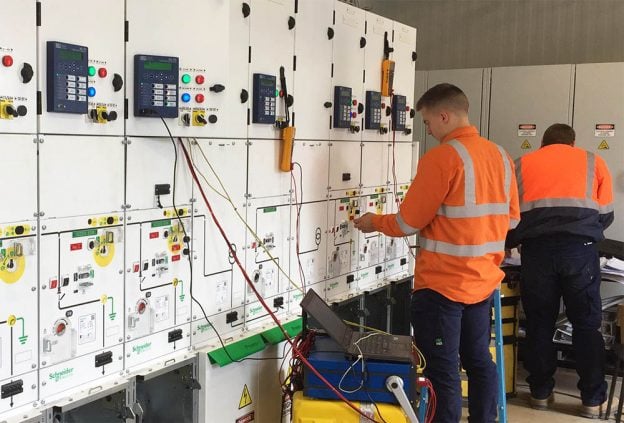Course Description
This course brings the essence of a medium voltage switchgear and its control and protection schematics. It focuses on the study of MV panel schematics and is structured so that no prior knowledge of schematics is assumed.
The instruction is broken down into five sections, each of which is dedicated to the explanation of a different schematic, such as tripping, trip circuit supervision, interlocking, indication circuits, and others.
Three busbars and two bus sections make up the study’s instance of an 11kV medium voltage switchgear’s single bus and single breaker arrangement. Each bus receives power from its own individual 132/11kV Power transformer, and an automatic bus transfer scheme is used, with the use of a numerical relay.
This course begins with the fundamentals and progresses to more complex topics. The emphasis is on providing the information that can be used immediately. As a first step, we’ll study together how to draw simple line diagrams and interpret their meaning. This course will equip you with the knowledge to read, understand, and interpret medium-voltage switchgear diagrams.
The training comes with a bonus: detailed diagrams of common feeder types.
One of the most important skills in engineering is the ability to understand various types of drawings. Engineering drawings are the backbone of any industry-standard procedure for communicating complex data necessary for setting up, troubleshooting, maintaining, and operating a system.
Becoming familiar with the typical practices and fundamental symbols used in such drawings is the initial step in learning to interpret them.
As a result of my 18 years working in MV commissioning, design review, and testing, I have developed this course, broken down the schematics, and pointed out design defects and improvements. As a result, you will learn not only to interpret the schematics, but also to conduct a thorough design assessment of medium-voltage switchgear with the help of the guidelines provided in this course.
What you will learn from this course?
- Understanding Single Line Diagrams
- Circuit Breaker Anti-Pumping Scheme
- Circuit Breaker Anti-Slam Scheme
- Seal in contacts
- Trip command duration
- Coordination of trip command duration
- Motor control circuit
- Spring charge indication
- Concept of limit switch
- Philosophy of auxiliary contacts
- How NO contact works, Normally Open contacts
- How NC contact works, Normally Close contacts
- 52a & 52b Contacts
- Binary input circuit
- Limit switches operation
- Trip & closing coil save contacts
- How loops are form in schematic
- DC Supply supervision & DC loop supervision
- How trip circuit supervision works
- Supervision of tripping coil in case CB is open and close position
- Concept of fake DC, return DC and solid DC
- ABB trip circuit supervision relay
- MVAX trip circuit supervision relay
- DC supply schematics
- Fuse Fail Relays, how they work
- Control operations, Local, Remote, Emergency and Remote schematics
- How control is transferred from lowest level to highest level
- Indication circuit, single point and double point indications
- Technique of contact multiplication and where it should be allowed.
- Trip circuit 1 & 2 for Incomer, Outgoing feeder, bus section, capacitor bank feeder
- Introduction to mechanical & electrical interlocks
- Test & Service positions
- Closing Circuit of the Circuit breaker
- Closing interlocks for incomer with protection & upstream devices
- Closing interlocks for outgoing feeder
- Closing interlocks for capacitor bank feeder
- Interlocks for test & service positions
- DC supply supervision scheme
- Feeders interlock with busbar earth switch
- Busbar earth switch interlock with feeders
- Busbar Earth Switch control
- Busbar VT schematics
- Bus Section Trip circuit schematics
- What is lockout(86) relays
- Lockout circuits of incomer/outgoing feeder/ bus section/ capacitor bank
- Capacitor bank door interlock circuit
- Single line diagram of incoming, outgoing, bus section and capacitor bank feeder
- Bus section interlocks
Course Summary:
- MV Switchgear SLD and Symbols, Components, Auxiliary Contacts
- Motor Charging and Anti-Pumping Circuits, Local-Remote Logic
- MV Schematics: Tripping Coils, Test Switch, Test Circuit Supervision and Interlocking
- Incoming Feeder: SLD, Closing, Tripping & Indication Circuits and Interlocking
- Bus Section, Capacitor Bank, Busbar VT and Busbar Earth Switch
Who Is This Course For:
- Substation engineers
- Practicing power system engineers
- Maintenance staff
- Electrical engineering students planning on pursuing a career in power engineering
- Power system protection engineers
Requirements:
- The basics of power systems
- Knowledge of basic substation terms
- Understanding the basic relay protection terminology and principles
- Passion and patience for learning.
Downloadable course materials
After purchasing the course, students can download the following related documents:
- 13.8kV Switchgear Single-Line Diagram (PDF)
- BB VT and BB ES Sec.A Drawings (PDF, 37 pages)
- Bus Section AB Drawings (PDF, 46 pages)
- Capacitor Bank Drawings (PDF, 35 pages)
- Incomer Drawings (PDF, 48 pages)
- Outgoing Drawings (PDF, 36 pages)
- MV Schematics Section 3 (PDF)
- MV Schematics Section 1-2 (PDF)
- MV Schematics Section 4 (PDF)
- MV Schematics Section 5 (PDF)
Guides, papers and studies:
- Operating philosophy for 132KV Trafo Line Bay Isolation & Restoration (PDF)
- Operating philosophy for 132KV Grid line Isolation & Restoration (PDF)
- SOP for Line trip and restoration (PDF)
- Single-Line Diagram and Interlocking Scheme (PDF)
- The basics of Gas Insulated Substation (GIS) for students (PDF)
- 400/220 kV gas insulated (GIS) transmission substation controlled by SCADA (PDF)
- Technical Specification For 220kV SF6 Gas Insulated Metal Enclosed Switchgear (PDF)
- The basics of high voltage switching equipment in power substations and switchyards (PDF)
- The basics of power system protection that every engineer should know about (PDF)
- A practical handbook for relay protection engineers (PDF)
Course Content
About Instructor



